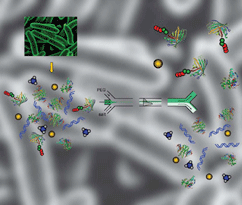NEWS RELEASES
FOR IMMEDIATE RELEASE
April 3, 2008
Lab on a Chip paper unveils protein purification process expected to enable discoveries in bioenergy research

Advances made by Sandia researchers in protein purification and analysis are described in the 2008 Volume 8 edition of Lab on a Chip, a microfluidics journal.
LIVERMORE, CALIF. — Sandia research is having significant impact on the emerging bioenergy arena through its work in protein purification and analysis. Recent developments in this technology space are recognized in the 2008 Volume 8 edition of Lab on a Chip – a leading microfluidics scientific journal – which features a Sandia paper on its front cover.
The paper is titled Rapid, continuous purification of proteins in a microfluidic device using genetically-engineered partition tags. Authored by Sandia/California’s Robert Meagher, Yooli Light, and Anup Singh, it describes a rapid, automated microscale process for isolating specific proteins from sub-microlitre volumes of E. coli cell lysate.
Sandia is a National Nuclear Security Administration laboratory.
“This novel approach addresses the need for high-throughput purification of minute amounts of native and recombinant proteins, which is currently necessary in drug discovery, enzyme engineering, and other life sciences”, says Sandia’s Robert Meagher, the lead author. High-throughput screening requires availability of large numbers of purified proteins, but current purification techniques are too slow, expensive, and hard to automate.
For bioenergy research, the microfluidics-based technique is key in that it will allow for much faster enzyme purification and analysis, provide a more automated engineering method, and use smaller amounts of cell mass to produce proteins.
“It (processing of biomass) can be a difficult and often costly process, but certain enzymes have been found to efficiently break down cellulose into sugars,” added Singh, senior author of the paper and manager of Sandia’s Biosystems Research department. Sandia’s technique, he says, combined with high-throughput cell culture methods, will allow thousands of enzymes and their variants to be purified and screened rapidly, which should significantly aid researchers as they search for the most optimal enzyme that meets their processing needs.
The effort, funded by Sandia’s internal Laboratory-directed Research and Development (LDRD) program and the Department of Energy’s Office of Science, will have significant impact on the recently-funded Joint Bio-Energy Institute (JBEI), where Sandia is contributing its expertise in science-based engineering, computational science, and microsystems. The lab’s capabilities in enzyme engineering, systems biology, membrane transport, protein expression, and hyperspectral imaging are all expected to contribute significantly to the DOE JBEI mission.
Sandia is a multiprogram laboratory operated by Sandia Corporation, a Lockheed Martin company, for the U.S. Department of Energy’s National Nuclear Security Administration. With main facilities in Albuquerque, N.M., and Livermore, Calif., Sandia has major R&D responsibilities in national security, energy and environmental technologies, and economic competitiveness.
Sandia news media contact: Mike Janes, 925-294-2447, mejanes@sandia.gov